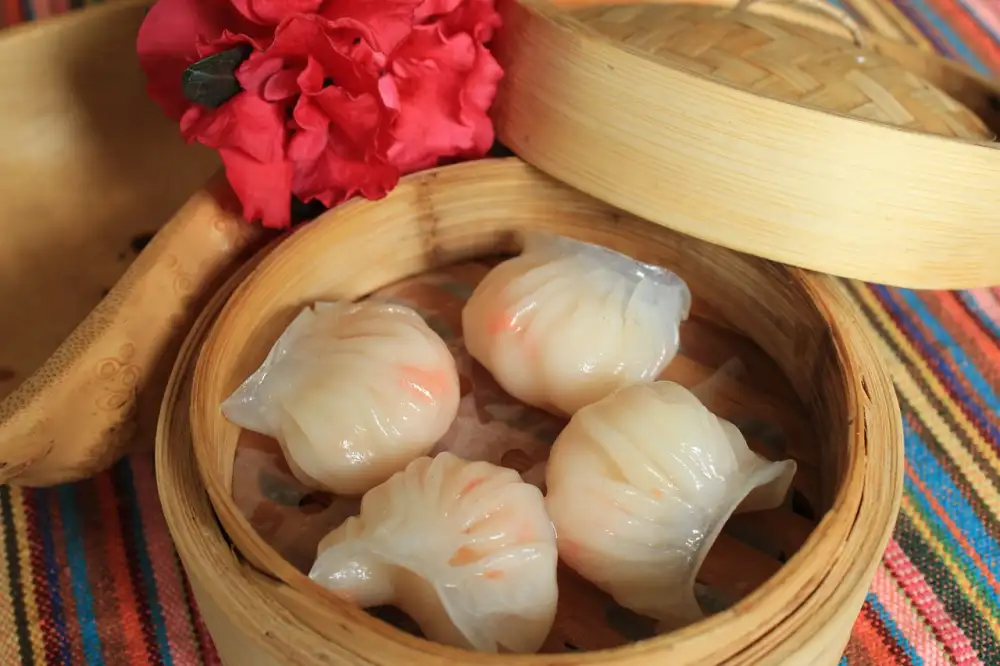Dumplings Delight: Savor the Flavors of Savory and Sweet Doughy Delicacies

- History and Origins of Dumplings
- Types of Dumplings from Around the World
- Ingredients Used in Dumplings
- Traditional Dumpling Fillings
- Popular Dumpling Dipping Sauces
- Cooking Methods for Dumplings
- Dumplings as Comfort Food
- Dumplings in Different Cuisines
- Dumplings as a Versatile Dish
- Dumplings as a Symbol of Togetherness
Dumplings, a beloved culinary delight, have been satisfying taste buds around the world for centuries. These delectable morsels are made by wrapping dough around a filling and then cooking them to perfection. Whether savory or sweet, dumplings offer a burst of flavors and textures that leave you craving for more. From delicate dim sum in China to hearty pierogies in Eastern Europe, dumplings come in various shapes, sizes, and fillings. Join us on a mouthwatering journey as we explore the wonderful world of dumplings and discover why they are truly a treat for the senses.
History and Origins of Dumplings
Dumplings have a rich history that dates back thousands of years. The exact origins of dumplings are difficult to trace, as they have been a part of many different cultures and cuisines throughout history. However, it is believed that the concept of wrapping dough around a filling originated in China during the Han Dynasty.
Dumplings were initially created as a way to preserve meat and vegetables by encasing them in dough. This allowed people to store and transport food more easily. Over time, dumplings became not only a practical food but also a symbol of prosperity and good luck.
As trade routes expanded, dumplings spread to other parts of Asia, including Japan, Korea, and Vietnam. Each country developed its own unique styles and flavors of dumplings. In Europe, dumplings became popular in countries like Germany, Poland, and Italy, where they are often served with hearty stews or soups.
Today, dumplings continue to be enjoyed all over the world. They have become an integral part of many cultural celebrations and festivals. Whether steamed, boiled, or fried, dumplings are loved for their comforting texture and delicious fillings.
The history of dumplings is a testament to the creativity and ingenuity of different cultures when it comes to food. From humble beginnings as a practical meal option to becoming a beloved culinary delight, dumplings have truly stood the test of time.
Types of Dumplings from Around the World
Dumplings come in a variety of shapes and sizes, each with its own unique flavor and texture. From Asia to Europe to the Americas, dumplings are a beloved culinary delight enjoyed by people all over the world. Some popular types include Chinese jiaozi, Japanese gyoza, Italian ravioli, Polish pierogi, Indian samosas, and Latin American empanadas. Whether steamed, boiled, fried, or baked, these diverse dumplings offer a taste of different cultures and cuisines.
Ingredients Used in Dumplings
When it comes to making dumplings, the ingredients used can vary depending on the type of dumpling and the cultural influence behind it. However, there are a few common ingredients that are often found in dumpling recipes.
The main component of most dumplings is the dough, which typically consists of flour, water, and sometimes salt or oil. The type of flour used can vary from all-purpose flour to rice flour or even potato starch, resulting in different textures and flavors.
For savory dumplings, fillings often include a combination of meat (such as pork, beef, chicken, or seafood) and vegetables. Common vegetables used include cabbage, carrots, mushrooms, onions, and garlic. These ingredients are usually finely chopped or minced before being mixed together with seasonings like soy sauce, ginger, sesame oil, and various herbs and spices.
Sweet dumplings have a different set of ingredients. They often contain fruits like apples, berries, or peaches as well as sweeteners such as sugar or honey. Some sweet dumplings also incorporate nuts like almonds or walnuts for added texture and flavor.
In addition to these basic ingredients, some regional variations may include additional elements like eggs or dairy products in the dough mixture. These variations contribute to the unique taste and texture profiles found in different types of dumplings around the world.
Overall, the simplicity of the ingredients used in dumplings allows for endless possibilities when it comes to creating delicious and satisfying bites. Whether you prefer savory or sweet fillings, there is a dumpling out there to satisfy every palate.
Traditional Dumpling Fillings
One of the most exciting aspects of dumplings is the wide variety of fillings that can be used. From savory to sweet, there is a dumpling filling to suit every palate. In Chinese cuisine, popular fillings include minced pork with cabbage, shrimp with chives, and beef with onions. Japanese gyoza often feature a combination of ground pork, garlic, ginger, and cabbage. In Korean mandu, you might find a mixture of ground beef or pork with tofu and vegetables. Indian samosas are typically filled with spiced potatoes and peas. And let's not forget about dessert dumplings! These can be filled with sweetened fruits like apples or cherries, or even chocolate and Nutella for an indulgent treat. The possibilities are endless when it comes to traditional dumpling fillings, making them a truly versatile culinary delight.
Popular Dumpling Dipping Sauces
No dumpling feast is complete without a delectable dipping sauce to enhance the flavors of these delightful doughy parcels. From tangy to spicy, there is a wide array of dipping sauces that perfectly complement different types of dumplings.
One popular sauce is soy sauce, which adds a savory and salty kick to the dumplings. It pairs well with steamed or boiled dumplings, allowing the umami flavors to shine through. For those who prefer a touch of heat, chili oil or chili sauce can be added to the soy sauce for an extra kick.
Another favorite is black vinegar, often mixed with soy sauce and sesame oil. This combination creates a tangy and slightly sweet flavor profile that complements both steamed and fried dumplings. The acidity of the vinegar cuts through the richness of the dumpling fillings, creating a harmonious balance.
For those who enjoy a refreshing twist, ginger scallion sauce is a popular choice. Made with fresh ginger, scallions, and oil, this sauce adds a zesty and aromatic element to the dumplings. Its bright flavors pair well with delicate seafood or vegetable-filled dumplings.
If you're looking for something creamy and indulgent, peanut sauce might be your go-to option. Made with ground peanuts, soy sauce, garlic, and other seasonings, this rich and nutty sauce complements fried or pan-fried dumplings beautifully.
Lastly, let's not forget about sweet dipping sauces! In some cultures, such as in parts of China or Japan, sweet soy-based sauces are used to dip dessert dumplings filled with fruits or sweet bean paste. These sauces add a hint of sweetness without overpowering the delicate flavors of the dessert fillings.
Whether you prefer bold and spicy or subtle and tangy flavors, there is undoubtedly a dipping sauce out there that will take your dumpling experience to new heights. So, don't be afraid to experiment and find your perfect pairing.
Cooking Methods for Dumplings
Dumplings can be cooked in various ways, each method adding a unique touch to their taste and texture. The most common cooking methods include boiling, steaming, frying, and baking.
Boiling is the traditional method for cooking dumplings. Simply drop them into a pot of boiling water and cook until they float to the surface. This method is ideal for delicate dumplings with thin wrappers.
Steaming is another popular method, especially for Chinese dumplings like dim sum. Place the dumplings on a steamer basket or bamboo tray and steam them over high heat until they are cooked through. Steaming preserves the moisture and flavor of the filling.
Frying dumplings creates a crispy exterior while maintaining a juicy interior. Heat oil in a pan and place the dumplings in a single layer. Fry until they turn golden brown on one side, then flip them over to cook the other side. This method adds an irresistible crunch to the dumplings.
Baking is less common but can be used for certain types of dumplings like pierogies or empanadas. Preheat the oven and place the filled dumplings on a baking sheet lined with parchment paper. Bake until they are golden brown and cooked through.
The cooking method you choose depends on personal preference and the type of dumpling you are making. Regardless of how you cook them, each method brings out different flavors and textures that make every bite of dumpling truly delightful.
Dumplings as Comfort Food
Dumplings have long been cherished as comfort food in many cultures around the world. There's something incredibly satisfying about biting into a warm, doughy dumpling that is filled with flavorful ingredients. Whether it's a steaming bowl of chicken and dumplings or a plate of pillowy pierogies, dumplings have the power to bring comfort and solace to those who indulge in them. The soft texture of the dough combined with the hearty fillings creates a sense of warmth and contentment that can instantly lift your spirits. No matter where you are or what you're going through, a plate of dumplings can provide a comforting embrace that soothes both body and soul. So next time you're in need of some culinary comfort, don't hesitate to dive into the delightful world of dumplings.
Dumplings in Different Cuisines
Dumplings are not limited to one particular cuisine; they can be found in various culinary traditions around the world. Each cuisine has its own unique take on dumplings, making them a versatile and beloved dish across cultures.
In Chinese cuisine, dumplings are known as "jiaozi" and are typically filled with a mixture of ground meat, vegetables, and seasonings. They can be steamed, boiled, or pan-fried. In Japanese cuisine, "gyoza" are similar to Chinese dumplings but often have a thinner wrapper and are usually pan-fried.
In Italian cuisine, dumplings known as "gnocchi" are made from potatoes or flour and can be served with various sauces. In Eastern European cuisines such as Polish and Russian, dumplings called "pierogi" are popular. They are typically filled with ingredients like cheese, potatoes, sauerkraut, or meat.
In Indian cuisine, dumplings called "momos" are commonly found in the Himalayan region. They are usually filled with minced meat or vegetables and steamed or fried. In Korean cuisine, "mandu" is a popular type of dumpling that can be boiled, steamed, or pan-fried.
These examples barely scratch the surface of the diverse range of dumplings found in different cuisines. From Latin American empanadas to Turkish manti to Jewish kreplach, each culture has its own unique twist on this delightful dish.
No matter where you go in the world, you're likely to find some form of delicious dumpling waiting to be savored. The beauty of dumplings lies in their ability to bring people together through shared enjoyment of these delectable treats. So next time you're exploring different cuisines, don't forget to indulge in the joyous world of dumplings!
Dumplings as a Versatile Dish
Dumplings are not only delicious, but they are also incredibly versatile. They can be enjoyed as a main course, appetizer, or even a dessert. With their wide range of fillings and cooking methods, dumplings can be customized to suit any taste or dietary preference. Whether you prefer savory or sweet, vegetarian or meat-filled, there is a dumpling out there for everyone. From steamed to fried, boiled to baked, the possibilities are endless when it comes to preparing dumplings. So next time you're craving something tasty and versatile, why not give dumplings a try?
Dumplings as a Symbol of Togetherness
Dumplings have long been cherished as a symbol of togetherness in many cultures. Whether it's the Chinese jiaozi, the Polish pierogi, or the Italian ravioli, dumplings are often prepared and enjoyed as a communal activity. Families and friends gather in the kitchen, sharing stories and laughter while folding delicate dough pockets filled with savory or sweet fillings. The act of making dumplings together fosters a sense of unity and connection, creating lasting memories that are passed down through generations. So next time you indulge in a plate of dumplings, remember that it's not just about the delicious flavors - it's about the shared experience and the bonds that are formed around this humble yet extraordinary dish.
In conclusion, the world of dumplings is a delightful one that offers a wide array of flavors and textures. From the savory to the sweet, dumplings have captivated taste buds across cultures and continents. Whether you prefer steamed, boiled, or fried dumplings, there is something for everyone to enjoy. So why not embrace this culinary adventure and dive into the delicious world of dumplings? Savor the flavors, explore different fillings and dipping sauces, and experience the joy of sharing this versatile dish with loved ones. Let dumplings be your passport to a world of culinary delight!
Published: 06. 12. 2023
Category: Food



